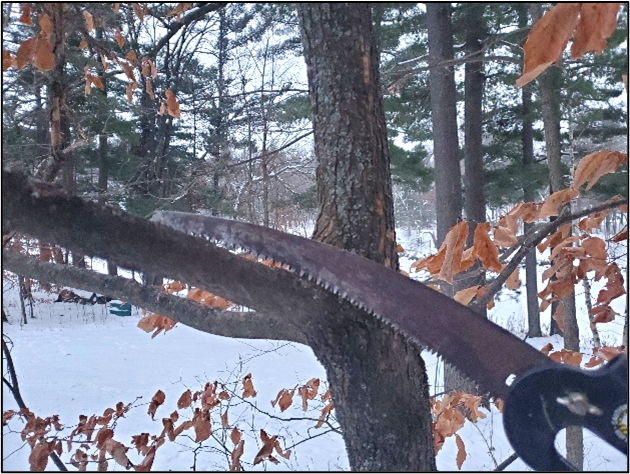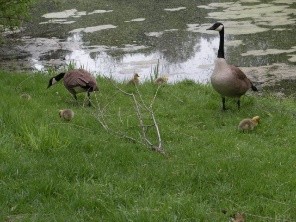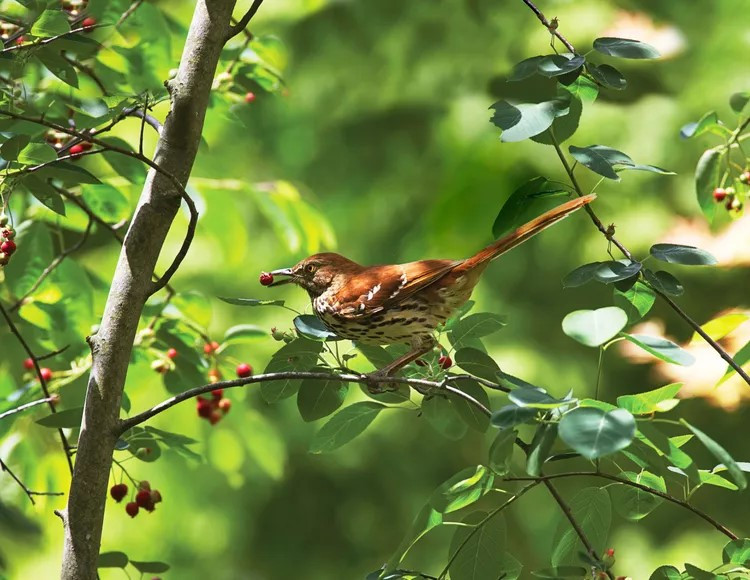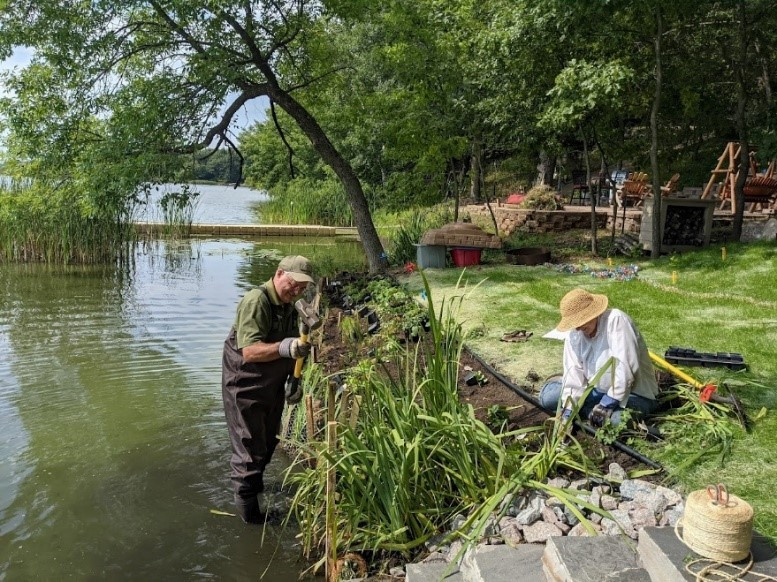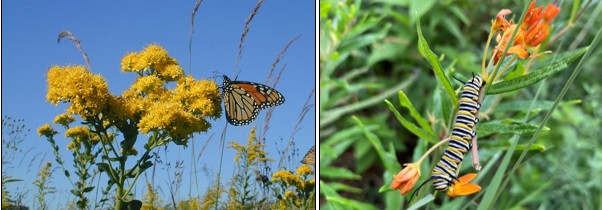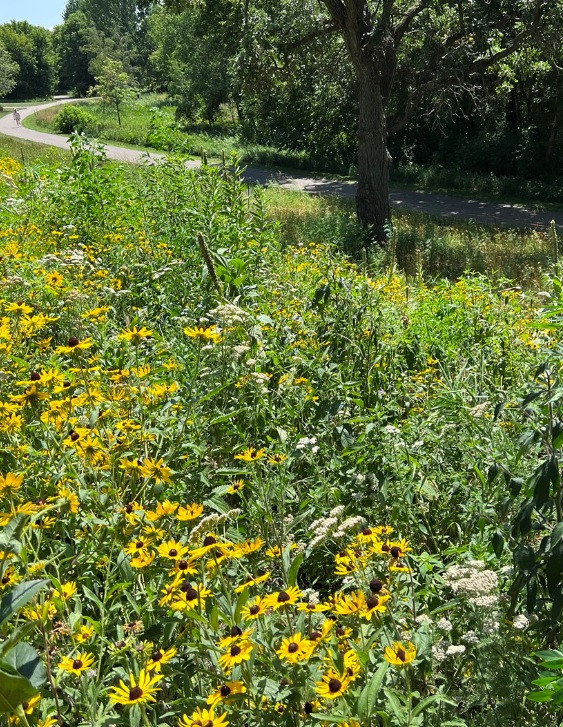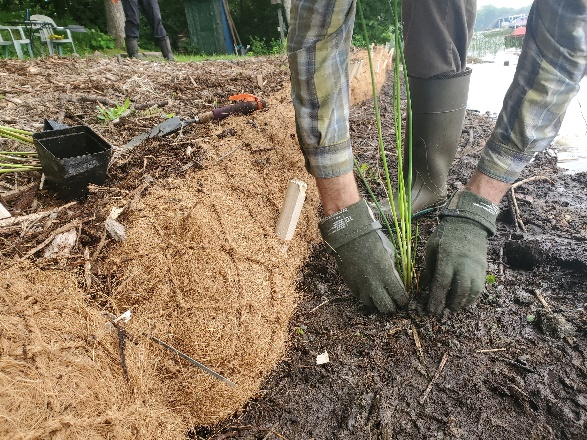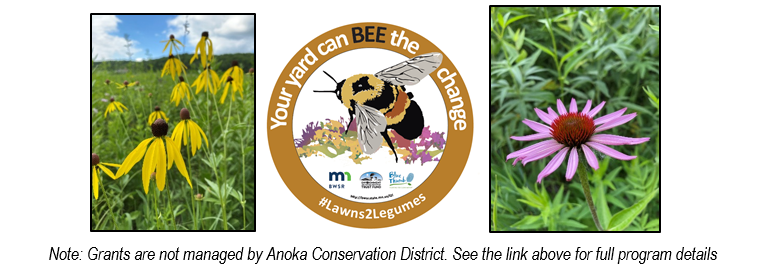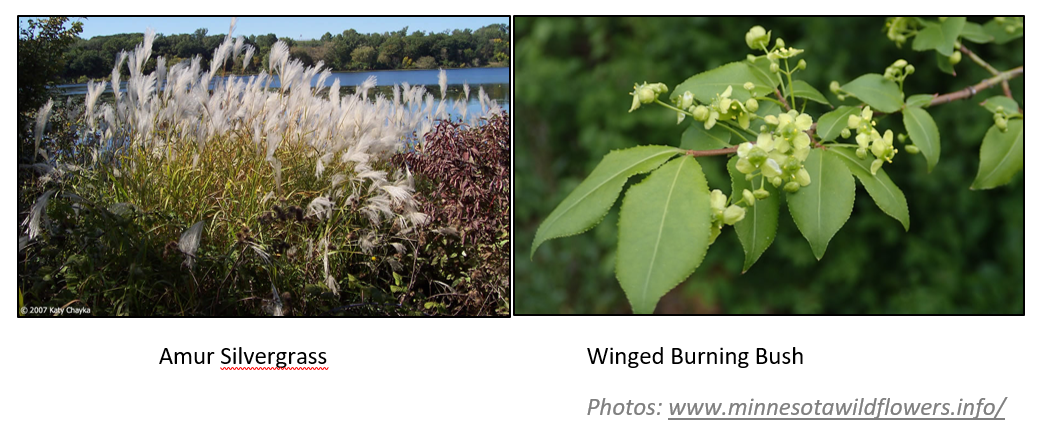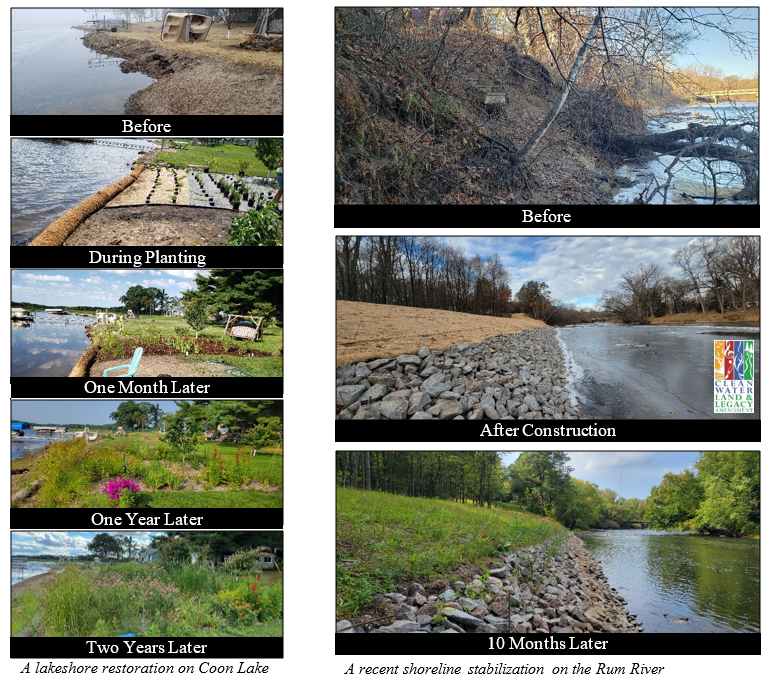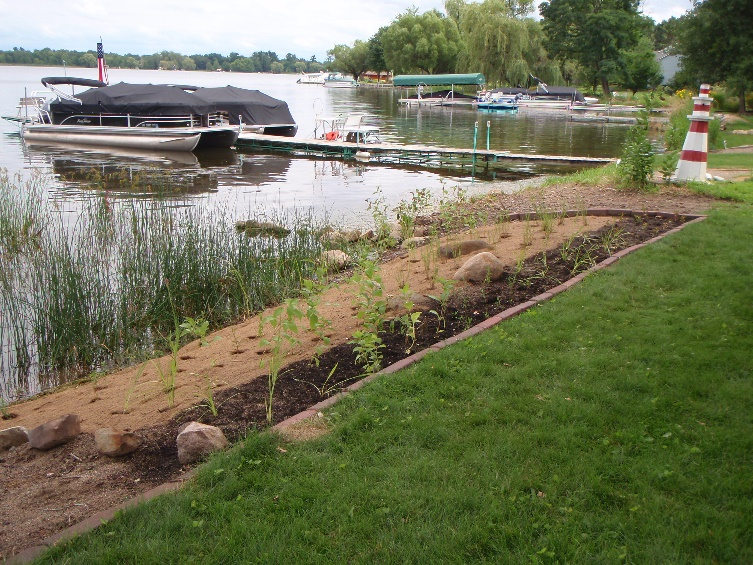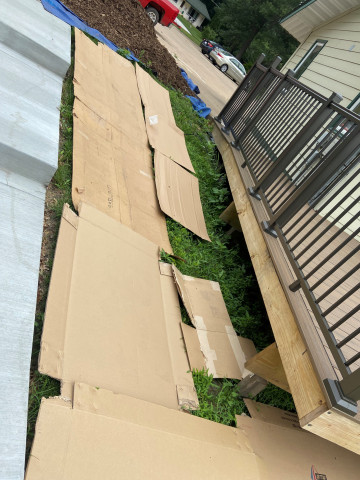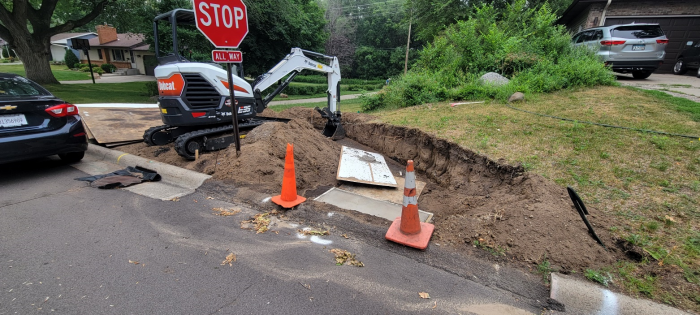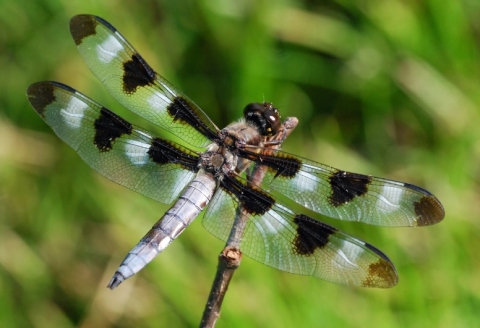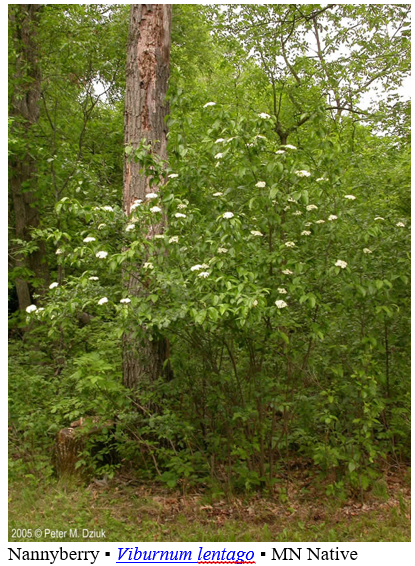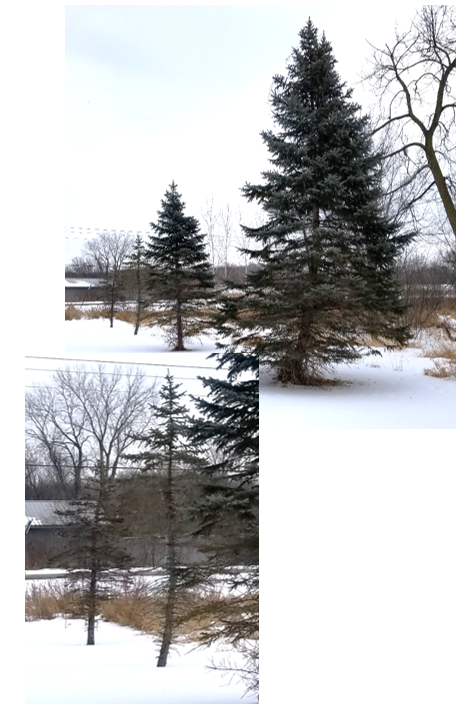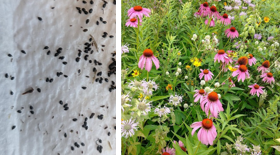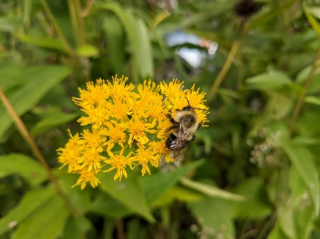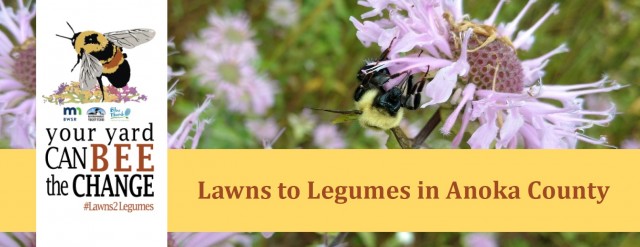The best time of year to prune most trees in Minnesota is winter. Wounds can heal while pests and diseases are at their winter standstill. It's also a good time to see the tree's form for attractive pruning. If you don't have trees (who couldn't use a few more?), ACD's annual tree sale is open. Trees are now being ordered and will be picked up in the spring. All are seedlings, available in bundles of 10 for $24-30 or bundles of 25 for $46-58. Prairie seed is also available. Please order early for the best selection; we intend to sell out of everything. Order online at www.AnokaSWCD.org. For more information contact Kathy Berkness, Office Administrator, at
Rain gardens capture and clean stormwater runoff before it reaches local waterbodies. Finding the right place to put one, especially a curb-cut rain garden that collects water from the street, takes more than just finding an open spot in the yard.
Several factors influence whether a rain garden will work effectively: the size of the area draining to it, the property's use, available space, landscaping features, and yard slope. While these things are easy to see, some of the most important considerations are hidden underground. Utilities such as water, sewer, gas, and electric lines must have adequate soil cover, and rain gardens can't interfere with these requirements. Soil is another key factor. Sandy soil allows water to soak in easily, while silt and clay soils may require special construction or make a site unsuitable for infiltration.
To explore where rain gardens can be most effective, the City of Fridley is partnering with ACD as part of a 2026 street reconstruction project. Properties in the project area with ideal conditions were identified, and those with interested landowners are now being evaluated for feasibility. Pairing rain garden installation with street reconstruction is a cost-effective way to manage stormwater in neighborhoods that currently lack treatment. With thoughtful planning above and below ground, curb-cut rain gardens can provide long-lasting benefits for both water quality and neighborhood beautification.
Financial assistance is available for landowners who wish to reforest their land. The Minnesota DNR's Field to Forest Program provides up to 75% reimbursement for tree planting expenses. Plus, a $500/acre incentive! The program requires planting a minimum of 3+ acres and is not intended for residential landscaping or planting in established forests. Contact your local DNR Forester by December 1, 2025, to apply. For more information about this program and others, please visit this link.
If that grant program isn't a fit but you'd still like to plant trees, ACD's annual tree is open. Trees are ordered now and picked up in the spring. All are seedlings, available in bundles of 10 for $24-$30 or bundles of 25 for under $46-$58. Prairie seed is also available. Please order early for the best selection; we intend to sell out of everything. Order online at www.AnokaSWCD.org.
ACD has developed informative videos on a variety of topics, all of which can be accessed on ACD's website and YouTube Channel. The videos cover topics such as signs and causes of erosion, river-friendly lawn care, and various best management practices. The "Our Connection" video series is both informative and easy to follow, and has become a valuable educational tool for teaching students about the environment. For more information contact Kathy Berkness, Office Administrator, at
Are you sick of goose poop covering your lawn? Plant a buffer of native grasses, flowers, and shrubs along your shoreline to keep them out! Geese are drawn to open spaces with short, well-fertilized grass, which provides them with a buffet of their favorite food and a sense of security with the ability to easily spot predators. Add water (your lake) to the mix, and you've created an easily accessible 'goose haven'. Taller, denser vegetation along the water's edge deters geese from accessing your lawn from the lake, encouraging them to move along in search of greener pastures.
The thicker the buffer, the more effective it will be. Not only do buffers discourage nuisance wildlife – they also provide a multitude of other benefits, including protecting your shoreline from erosion, improving water quality, and providing food and habitat for pollinators. You can use this helpful collection of technical resources, produced by the Minnesota DNR, to plan your buffer project. For more information, contact Breanna Keith, Water Resource Specialist, at Breanna.Keith@AnokaSWCD.
A rain garden was recently completed to benefit water quality in Coon Lake. This is the third rain garden in that neighborhood, each treating stormwater from a different section of the street. Previously, all curbside runoff was piped to the lake. This project was a collaboration between the Sunrise River Watershed Management Organization, ACD, and the landowner. Funding was from a grant from the Clean Water, Land, and Legacy Amendment.
Vernal pools are shallow wetlands that fill with water in the spring and fall, then often dry out in the summer. They may appear like large puddles, but these depressions are brimming with life and help improve water quality. By capturing water from snowmelt and heavy rainfall, vernal pools reduce the amount of runoff (and therefore the contaminants it carries) reaching nearby surface waters and developed lands. This lowers flooding risks, improves water quality, and contributes to groundwater recharge as the trapped water slowly infiltrates through the soil.
Vernal pools rarely contain fish because their water levels fluctuate dramatically. This creates a safe haven for many amphibians and aquatic invertebrates that would otherwise be heavily preyed upon. While some depend on vernal pools during only their vulnerable egg and larval stages, others spend their entire life within or near them. These small wetlands also provide food, water, and refuge for many other wildlife species such as ducks, turtles, and snakes. Benefits stem beyond the pool itself as several aquatic insect larvae transform to flying adults, serving as forage for insectivores like songbirds and bats.
Vernal pools are highly sensitive to environmental changes. Because they are nearly invisible for much of the summer, they can be easily missed and destroyed if the land is modified. You can help protect vernal pools on your property by noting their boundaries when visible in the spring and avoiding disturbance throughout the year. This is also a great time to explore the abundance of wildlife in and around these wetlands! For more information contact Breanna Keith, Water Resource Specialist, at
Additional Resources
"Spring-to-Life Ponds": an Illustrated Learning Guide, produced by the MNDNR
MN Frog ID and Calls and Common Vernal Pool Invertebrates, produced by the MPCA and the University of Wisconsin
Locating and Protecting Vernal Pools, produced by the MN Land Trust
ACD has secured over $78,000 - including $71,000 in state Watershed-Based Implementation Funds and $7,100 in local matching funds from the City of Fridley - to revitalize aging rain gardens in the Coon Creek Watershed.
Many rain gardens are now beyond their original 10-year lifespan, yet still hold potential for managing urban stormwater runoff. This project will remove accumulated sediment, repair infrastructure, and improve plantings within up to 10 rain gardens. The work will increase the rain gardens' ability to capture and filter pollutants from stormwater runoff, thereby reducing phosphorus by an estimated 5.2 pounds annually for the next decade.
These efforts represent targeted investments in existing infrastructure to provide cost-effective water quality benefits. Existing rain gardens in the Coon Creek Watershed that are 10+ years old will be analyzed, and those with the most benefit potential will be revitalized. Maintenance agreements will help ensure long-term success.
Work will begin in 2025 with site analysis, potential benefit estimates, ranking, and site selection. Designs, bidding, and rain garden revitalizations will follow. For more information, contact Mitch Haustein, Stormwater & Shoreland Specialist, at
Designs have been completed and construction planning is underway for nine shoreline restorations on Martin, Coon, and Linwood lakes in Anoka County. Sites were selected based on the severity of erosion, and therefore the amount of nutrients and sediment they're contributing to the lake. A variety of 'bioengineering' approaches will be applied, utilizing natural materials such as vegetation, wood, coir logs, and rock to stabilize the shoreline while enhancing habitat for fish and wildlife. Funding is provided by a Clean Water Fund grant, the Sunrise River Watershed Management Organization, and landowner match. Stay tuned for more updates! For more information contact Breanna Keith, Water Resource Specialist, at
When confronted with something eating your prized tomato plant, sometimes our first instinct is to pick up the bottle of pest spray. Oftentimes, we don't even realize that the plants we've purchased contain neonicotinoids, which are systemic (within) the plants' leaves, stems, flowers, nectar, and fruit. These 'neonics' are highly effective in killing pests, but they lack discrimination, and mounting evidence suggests they are contributing to the decline in pollinator numbers. An alternative is called IPM or Integrated Pest Management. The concept is to address pest infestations as they occur and manage pest damage on an as-needed basis, rather than chemically on a predetermined schedule.
Cultural practices may include:
- Is it a pest? Many of our most beautiful butterflies will use our garden or yard as a source of food, as well as caterpillars! If you can't identify the insect snacking on your plant, try contacting the Anoka County Extension Service for help with identification or go online. There are free apps that can help identify many insects, including iNaturalist, which can also help identify plants
- Regular compost additions to maintain a healthy population of soil organisms
- Crop rotation to avoid inadvertently helping pests thrive via monoculture
- Companion planting to attract beneficial insects while reducing the attraction of pests
- Using physical barriers like fine mesh netting and row covers to prevent pests from reaching crops
- Hand removing larger pests from plants when practical, Japanese beetles are a good example. Late afternoon is a good time to find these bugs and dispose of them in soapy water.
- Maintaining garden hygiene by removing diseased and end-of-season vegetation from the garden and disposing of it properly.
Biological and habitat controls include:
- Importing predators and parasitoids that prey on the pests of concern. Note that specific pests demand specific predators and predators need a food source to stay in the garden area. Generally, if you have managed your garden then the 'good' insects will naturally find their way to your garden and assist with pest control.
- Maintaining a chemical-free habitat that is welcoming to beneficials and pollinators
- Using resistant plant varieties means researching and selecting the best available hybrids that are resistant to likely pest challenges.
When nothing else works and damage levels warrant continued action, research the organic and manufactured chemical options for the specific pest in question. Insecticidal soaps are a good option for many sucking and chewing pests. Neem oil is similarly safe on food with no dangerous residues while killing or reducing pests, powdery mildew, and other fungal infestations. If all else fails and traditional pesticides are used, follow label directions carefully, use them minimally, and avoid spraying open flowers and applying them during the day when pollinator activity is highest.
The Harder Path is the Right Path
As is often the case, the more convenient approach — using neonicotinoids and other chemicals on a widespread basis in anticipation of pest problems — is seductive but ultimately harmful in the long term. Damage to pollinators, faster evolution of resistant pests and replacement of natural processes with chemicals are all costs that eventually have to be faced. The IPM approach requires more work and acceptance of a certain amount of pest damage. We must reduce and manage the use of neonicotinoids and other agricultural chemicals, as their long-term impact will be far more harmful than beneficial. Do it for the bees. Do it for the butterflies. Do it for the birds. Do it for you.
An excellent resource for more information is the University of Michigan's website: https://ncipmhort.cfans.umn.edu/ipm-bmp-cultural-control/vegetable-garden-best-management-practices-pollinators.
Spring is the perfect time to upgrade your lawn irrigation system. Smart irrigation tools—such as Wi-Fi-enabled controllers, soil moisture sensors, and rain sensors—help your system adjust automatically based on weather and soil conditions. These upgrades take the guesswork out of watering and prevent overwatering.
Thanks to the Metropolitan Council's Water Efficiency Grant Program, funded by the Clean Water, Land, and Legacy Amendment, several Anoka County cities are offering rebates for smart irrigation controllers that reduce water waste and lower your water bill. Click the links below or check with your city to learn more about eligibility and how to apply.
- Smart irrigation controller rebates: Centerville, Coon Rapids, Fridley, Lino Lakes, Ramsey
- Irrigation audits to assess water efficiency: Fridley
Smart irrigation is a simple, effective step toward more resilient water resources—right here in Anoka County. Visit the University of Minnesota Extension's Lawn Care website for additional lawn management resources. For more information contact Mitch Haustein, Stormwater and Shoreland Specialist, at
ACD wraps up another successful annual tree sale! Over 26,000 trees were purchased as bare-root seedlings in bundles of ten or twenty-five. We offered a variety of species including black cherry, mixed oak, maple, lilac, pine trees, and a variety of native prairie seed mixes. We had perfect weather on pick-up day and our staff enjoyed getting the chance to meet and engage with the 466 tree sale customers. Thank you to everyone who purchased trees and helped support local conservation efforts! Check out a recap of our 2025 Tree Sale below!
Here are ways you can help pollinators and birds in your yard:
- Plant Native Plants
- Don't Buy Plants Treated with Neonicotinoids
- Avoid Pesticides
- Provide Water or a Birdbath
- Leave Bare Soil and Old Stems for Bee Nests
Apply to ACD's Lawns to Legumes Pollinator Pathway Native Plant Grant:
Eligible project practices include:
- Native pocket plantings
- Beneficial flowering tree and shrub plantings
- Pollinator-friendly lawns
- Pollinator meadows
Applications can be submitted via Google Forms or paper applications are available upon request. Questions can be directed to Jordi Johnson:
ACD's pollinator conservation programs were made possible by grant funding from BWSR and the National Fish and Wildlife Foundation's Monarch Conservation program. For more information contact Logan Olson, Restoration Technician, at
ACD's tree sale is right around the corner! Trees and shrubs are sold in bareroot seedlings or transplants, ranging from 8" to 18" in height. They may be purchased in bundles of ten for $24.00, or twenty-five for $47 not including tax. Native prairie seed and tree aides are also available. You do not need to be an Anoka County Resident to order. The order form is organized to group native trees and shrubs according to their ecosystem and non-native trees and shrubs based upon their primary use. Call 763-434-2030 x 100 or email
Do you have some corners of your property that are hard to mow or just need a little spruce up? ACD staff recently replaced turf with native plants alongside our parking lot. This area of the yard is steeply sloped and difficult to mow. The 300 sq ft area is now home to nearly a dozen species that will benefit pollinators. In recent years we converted the area around some clumped oak trees into a shrub garden. Those shrubs have matured nicely and required no care. In another area, we simply stopped mowing. The resulting grass is still short (<6") and falls over on itself. The area is easy to walk across, and cuts down on our maintenance.
Do you want to start a new garden or fill in some gaps? Fall is a great time to plant. The soil is still warm and promotes good root growth and the cooler weather and fall rainfall reduce heat stress on new plants. Select plants based on the area's soil moisture and light exposure. Blue Thumb's Plant Finder is a great tool for selecting native plants and has a list of MN native plant nurseries. Protect pollinators! - Be sure the plants you buy were not grown with systemic pesticides such as neonicotinoids, which are highly toxic to bees and other pollinators.
Choose plants to create habitat for birds and pollinators. Find bird-friendly native plants with Audubon's plant database. Select plants that flower from spring to fall to provide pollen and nectar for pollinators. Learn more about pollinator preferences and include host plants in your garden. Join ACD and help plant pollinator gardens throughout Anoka County. Learn more and sign up here. For more information contact Carrie Taylor, Restoration Ecologist, at
Lakes provide habitat for wildlife, recreation opportunities, and natural beauty. Yet, our everyday landscaping choices can negatively impact these vital bodies of water.
Lake-friendly landscaping provides many benefits, and purposeful design can ensure you don't need to compromise access to the water or lakeside recreation opportunities.
What Is Lake-Friendly Landscaping?
Lake-friendly landscaping focuses on reducing pollution and preserving the health of our lakes. It involves making mindful choices in how we design and maintain our outdoor spaces to minimize runoff, limit chemical use, and support natural habitats.
Top Tips for Lake-Friendly Landscaping
1. Minimize Lawn Area: Lawns often need a lot of water and fertilizer, which can lead to nutrient-laden runoff. Reducing lawn space and incorporating groundcovers or mulched areas can help decrease runoff and save time on maintenance.
2. Install a Native Plant Buffer: Native plants are adapted to our local environment, requiring less water, fertilizers, and pesticides. A buffer of native grasses, flowers, shrubs, and trees can serve as a natural filter, trapping pollutants and preventing them from reaching the water. Native plant root systems also help reduce soil erosion, both along the shoreline and upslope, preventing excess nutrients from washing into lakes. If you prefer a more formal garden appearance, cluster plants of the same species throughout the area to create a planned look. Frame your lake view by planting taller species along the property boundaries and shorter species toward the center.
3. Manage Stormwater Runoff: Be intentional about where runoff from your property is routed. Directing runoff to rain gardens, permeable areas, or rain barrels will reduce the volume of runoff carrying pollutants directly to the lake.
4. Educate and Involve the Community: Spread the good news; share these practices with neighbors and participate in local conservation efforts. Community-wide adoption of lake-friendly landscaping can have a significant positive impact.
To learn more about lake friendly landscaping contact Mitch Haustein, Stormwater & Shoreland Specialist, at
In 2023, ACD coordinated the installation of several lakeshore restorations on Lake George, in northwestern Anoka County. High lake levels this spring, mixed with heavy winds, resulted in several of the projects being damaged. This summer, ACD staff and a Conservation Corps field crew were able to make repairs and enhance the projects so that they will be prepared for future weather events. For more information contact Brian Clark, Natural Resource Technician, at
ACD is in the final stages of completing eight shoreline stabilization projects at Martin Lake in Linwood Township. The projects stabilize over 700 linear feet of shoreline. Each project includes a native plant buffer and many include in-lake emergent plants. These projects were funded by the landowners and a grant from the Clean Water, Land and Legacy Amendment. For more information contact, Watershed Projects Manager, Jamie Schurbon at
Planting native plants and nectar-rich flowers, supplying food and water sources, and avoiding pesticides are some of the keystones for attracting wildlife to your garden. Different species of pollinator prefer different shapes of flowers. Some like flat clusters of tiny flowers, and others seek out trumpet-shaped blossoms. Native plants such as coneflower, New England aster, and butterfly weed offer a variety of flower shapes to attract a variety of wildlife. Planting indigenous flowers and grasses among native trees and shrubs creates a self-sustaining environment. Plus, native plants require less maintenance than non-native species because they are better suited to the soil and climate.
Keep an eye out for invasive plants that may try to sneak into your garden. These include purple loosestrife, Japanese knotweed, crown vetch, and multiflora rose, all of which can spread rampantly. There are free apps you can download to help you identify plant species. A pond can provide refreshing drinks for wildlife and habitat for fish, frogs, and other water-loving creatures. Thoughtfully placed plants, including hardy water lilies and arrowhead in and around the water are key ingredients for a healthy ecosystem.
Bird baths are a simple way to attract wildlife, especially feathered friends who appreciate a place to safely drink and bathe.Birds prefer shallow basins no more than 2 inches deep with a rough surface for good gripping. For protection against lurking cats and other predators, place a bird bath a few feet from a tree or shrub so that the area immediately surrounding it is open yet close enough to sheltered perches for quick getaways.
While adult butterflies fly from flower to flower sipping sweet nectar, their wriggly offspring are content to feast on a single host plant. Parental instinct guides each species to lay eggs on the plants their offspring favor. Favorite caterpillar cuisine includes parsley, dill, fennel, milkweed, willow, Queen Anne's lace, spicebush, and white clover. Pesticides can cause harm to the butterflies and bees you're trying to support. If you plant a diverse mix of plants, especially natives, pests are unlikely to do much damage to your garden so it's best to accept a little imperfection just let nature take its course.
Birds such as robins, brown thrashers, and cedar waxwings flock to landscapes that feature fruit-bearing trees and shrubs. Native species that fit into yards large and small include serviceberry, crabapple, and hawthorn. Don't try to do all this at once! Pick one project this summer and add it to your yard. You'll notice the change immediately. As time goes on; you can keep modifying and make changes as you go. Enjoy! Learn more from the source article or contact Becky Wozney, Wetland Specialist, at
Stormwater runoff from Fridley's Channel Rd. NE neighborhood currently flows to and through the storm sewer network directly to Rice Creek, untreated. This is a common occurrence in well-established neighborhoods built prior to stormwater treatment regulations. However, thanks to collaboration between the City of Fridley, Rice Creek Watershed District (RCWD), ACD, and private landowners, this neighborhood with soon be retrofitted with four curb-cut rain gardens designed to reduce water volume and pollutants entering Rice Creek.
These gardens have been strategically located throughout the neighborhood in order to capture as much runoff as possible. The benefits of infiltrating this stormwater will amount to an estimated reduction of 56,192 cubic feet of water, 3.57 lbs of phosphorus, and 677 lbs of total suspended solids to Rice Creek per year. Each garden will also be densely planted with native forbs, grasses, and shrubs to provide improved water infiltration and pockets of high-quality habitat in a highly developed landscape.
Funding is provided by the RCWD's water quality cost share program and the City of Fridley. Landowners at each garden site have voluntarily enrolled in this opportunity and have agreed to maintain these gardens to ensure long-term functionality. For more information contact Breanna Keith, Water Resource Specialist, at
This June, ACD is planting 10 lakeshore buffers, part of a shoreline stabilization totaling nearly 800 feet of shoreline at three lakes. Native plants help hold in place the shoreline soils against erosion and provide near shore habitat. ACD and its project partners, such as the Sunrise River Watershed Management Organization, have goals of increasing native and stable shorelines.
"Disappearing" natural shorelines is affecting lake health at many waterbodies in the region. ACD staff regularly assists homeowners who wish to do native shoreline buffers. With a little guidance, these projects can be do-it-yourself installation, or professionally installed. Cost share grants are available. Big or small, each is a step toward healthier, cleaner lakes and rivers. For more information contact, Watershed Projects Manager, Jamie Schurbon at
ACD is looking for volunteers to participate in upcoming Monarch and Monarch habitat monitoring efforts. ACD will host a number of volunteer events this summer in natural areas across Anoka County. We will provide all the training and materials you will need. Your work will contribute to a national dataset helping conservationists better understand and protect the Monarch.
As a volunteer you will be trained to:
- Identify blooming prairie plants which provide Monarch habitat resources
- Find and observe Monarch eggs and larvae
- Record activities of adult Monarchs
Join us for this fun opportunity to explore natural areas of Anoka County while learning about Monarch conservation! You can indicate your interest in volunteering this summer by completing a quick google form. For more information contact Logan Olson, Restoration Technician,
Adapted from: Matthew Russell is a Minnesota Extension specialist in forest resources.
Emerald ash borer (EAB) has left a wake of dead ash trees throughout 4.3 million acres across the state. Minnesota forests are home to three native ash species. Unfortunately, all of these ash trees are susceptible to EAB. Here are seven native tree species that you can research for replacing your ash. Each species has its own unique characteristics and are adapted to different environmental conditions.
American Elm (disease-resistant elm varieties) Like ash, elms can tolerate wet conditions. Elms are slightly different in that they require full sun for the best growth.
Quaking Aspen Aspen sprouts vigorously, a form of reproduction without using seeds. It is often one of the first species to come back to an area after a timber harvest or fire.
Northern White Cedar In its natural habitat, it can form dense stands and survives well in moist soils. Northern white cedar trees will attract wildlife. Cedar trees are a favorite of white-tailed deer.
Swamp Oak This species can tolerate heavy and wet soil, which makes it a good replacement for black ash. While native only to southeastern Minnesota, swamp white oak is known as a climate change "winner" and has been planted with success in research trials in northern Minnesota.
Hackberry It can survive heat and drought or wind and ice, making it suitable for Minnesota's climate. In its native habitat it can be found in floodplains and along rivers in the central and southern portions of the state.
Silver and Red Maple are common in southern Minnesota and grow into the north-central part of the state, typically along rivers. These maples are widely planted as a shade or ornamental trees. Silver maples leaves are are green on top and "silvery" on bottom and red maple leaves turn a brilliant red in the fall, giving the trees their names.
River Birch can thrive in floodplains and near stream banks. River birch can be a single or multi-stemmed tree, making it a great tree to consider for the landscape around your home. Its copper-colored bark makes it stand out from other common trees.
Diversifying the types of species you plant in your yard or woodland gives you reassurance that your landscape can survive future insect and disease outbreaks. For more options, Extension's replacement trees for ash page can help you figure out which trees will grow well in your plant community. Consult an arborist or forester for more advice to make sure you plant the right trees in the right spot.
For more information contact Becky Wozney, Wetland Specialist, at
Dreaming of warmer weather and gardening season? Applications are now open for Fall 2024 individual Lawns to Legumes grants! Minnesota residents are eligible to apply for $400 reimbursement grants for creating native pollinator habitat on their properties. Projects can take the form of small pocket plantings, larger pollinator meadows, or pollinator friendly lawns. Grant recipients are selected by a lottery system. The application closes on May 15th. Check out the MN Lawns to Legumes page for a plethora of resources on pollinator garden design, selecting native plant species, and maintaining pollinator habitat.
Note: Individual Lawns to Legumes grants are distributed at the state level, not by ACD. You can find contact information for assistance with these programs at the links above. For more information contact Logan Olson, Restoration Technician, at
Dreaming of warmer weather and gardening season? Applications are now open for Fall 2024 individual Lawns to Legumes grants! Minnesota residents are eligible to apply for $400 reimbursement grants for creating native pollinator habitat on their properties. Projects can take the form of small pocket plantings, larger pollinator meadows, or pollinator friendly lawns.
Grant recipients are selected by a lottery system. The application closes on May 15th. Check out the MN Lawns to Legumes page for a plethora of resources on pollinator garden design, selecting native plant species, and maintaining pollinator habitat.
Note: Individual Lawns to Legumes grants are distributed at the state level, not by ACD. You can find contact information for assistance with these programs at the links above.
ACD is now taking orders for the 2024 tree sale! The district offers a variety of species including black cherry, mixed oak, maple, lilac and pine trees. Trees can be purchased as bare root seedlings in bundles of ten for $23.00, or twenty-five for $45.00, not including tax. Mixes of native prairie seed are also available. You do not need to be an Anoka County resident to order. Click here to learn more and place your order today! For more information contact Kathy Berkness, Office Administrator,
ACD strives to build resilient pollinator corridors throughout Anoka County. This goal is accomplished by protecting and enhancing existing habitat and creating new habitat. ACD is fortunate to have local partners who also share this vision and are helping identify unused turf areas that can be converted to native plantings. ACD is currently working with the Cities of Fridley and Blaine to convert turf into prairie plantings in public green spaces. Half an acre of turf is being converted in Fridley's Commons Park and 0.3 acres of turf to prairie at Blaine's Laddie Lake Park. Staff from both cities prepared the sites and mowed the sites to prevent weeds from seeding. ACD staff seeded the sites in the spring. Members of the Cities and multiple volunteer groups planted native grasses and wildflowers to add to the seed mix.
These projects are funded by BWSR's Habitat Enhancement Landscape Pilot (HELP) grant. Other ACD HELP turf to pollinator projects are at Coon Lake County Park, Bunker Hills Regional Park and Ramsey River's Bend Park. The BWSR HELP grant also provides funds to enhance native prairies at the Cedar Creek Conservation Area, Bunker Hills Regional Park, Rum River Central Regional Park, Rice Creek Chain of Lakes Park Reserve and Mississippi West Regional Park.
One way to help these projects is to donate your native prairie seeds, including milkweed seed. See ACD's previous post about milkweed seed collection. Watch this short video to see butterfly milkweed seed cleaning.
For more information contact Carrie Taylor, Restoration Ecologist, at
Native wildflowers, grasses, sedges, and shrubs provide numerous benefits to wildlife habitat, soil health, and water quality. They are also generally more resilient to fluctuations in temperature, precipitation, and foraging by wildlife than non-native species. However, native plantings can still be impacted by disturbances such as weather or the growth of invasive and weedy species. For these reasons and especially if a specific landscaped look is desired, maintenance is still required to help native plantings thrive and look their best.
Plants are most susceptible to die-off within the first 3-5 years of being planted. During this initial period, it is essential to frequently weed, water, and re-plant in areas where losses occur. Once established, native vegetation requires less maintenance but should still be regularly inspected for weeds and pruned or thinned as needed to ensure there is adequate sunlight available for all species. Large-scale restorations such as the conversion of former agricultural fields to prairie may require regular management through prescribed burns, grazing, or mowing to mimic cycles of natural disturbance and new growth.
The most common barriers to achieving success in establishing native plants is failing to water and remove weeds. These two actions make a big difference in the appearance and function of native landscaping features, as shown in these two photos – one of which is regularly weeded and watered (above left) and the other which has received less maintenance (above right).
You can take several steps to make native landscape maintenance easier. First, make sure the species you plant are well-suited to the soil and sunlight conditions on your property. Plant into erosion control fabric or mulch to help reduce weed growth. Learn to identify the native species you choose and plant them in clusters to make it easier to spot weeds that pop up. Water native plantings, especially during times of drought. Weekly maintenance, especially during the critical establishment period, strongly increases the likelihood of success and prevents these tasks from becoming overwhelming. If weeds have taken over or you've noticed die-off in your native landscapes, it isn't too late! Use the following resources to help guide your native landscape rehabilitation endeavors.
- Common weed ID – quick guide
- Invasive plants and suggested replacements
- Comprehensive information: native plants for sustainable landscapes
From Landowner, City of Andover:
Thanks for the encouragement, it's been quite the journey. So many more pollinators, less wasp problems around our house, and more butterflies! Even though there are lots of weed problems (buckthorn), crown vetch, and garlic mustard. And this is with one year of site prep! Crazy stuff… it is very encouraging to see how creation relies on each part of each other and the interaction between plants, animals, bees, etc. is fascinating to watch!
There were no current cost share funds available but ACD has been providing technical assistance to many landowners who are interested in starting prairies. Throughout Anoka County there is a lot of interest in prairie restoration.
For more information contact Carrie Taylor, Restoration Ecologist, Carrie.Taylor
Six curb-cut rain gardens were installed approximately one-year ago and have been capturing runoff and its associated pollutants ever since. With each rainfall, runoff flowing in the street gutter is redirected into the rain gardens via a cut in the curb. Following a rain event, the water that enters the rain gardens is able to soak into the ground, which better mimics the natural hydrology before impervious surfaces (e.g. roofs, driveways, roads, etc.) and storm sewers directed runoff directly to Rice Creek. The rain gardens are able to store water and are filled with native species that were carefully selected for the site-specific conditions (e.g. light, soil type, and moisture).
Cumulatively, the six rain gardens are estimated to infiltrate 455,000 gallons of water, as well as remove 605 pounds of sediment and two pounds of phosphorus loading to Rice Creek annually. The native plants help to maximize infiltration and provide the co-benefit of pollinator habitat. One additional rain garden is located adjacent to a trail entrance into Locke County Park, providing an excellent public education opportunity.
These rain gardens were installed in partnership with the landowners, the City of Fridley, and the Rice Creek Watershed District. ACD provided design services and construction oversight.
The rain garden shown in the pictures below was planted last summer and as you can see, it didn't look like much at the time. Now, it looks beautiful and is full of flowers which pollinators love! This rain garden captures curbside runoff from 6.5 acres of neighborhood which previously went untreated to the Rum River. The native plant's roots create channels through the soil and reduce compaction, ensuring a maximum amount of water can infiltrate into the ground. The homeowners who worked with ACD to make this rain garden a reality, kept weeds at bay, and provided irrigation for the new plants during drought conditions!
Project funding was from the Clean Water, Land, and Legacy amendment, and the Lower Rum River Watershed Management Organization. To see other rain gardens installed throughout Anoka County, please see the virtual project tour on ACD's website.
For more information on rain gardens in Anoka County contact Mitch Haustein at
Shorelines are some of the most valuable real estate. Both financially and ecologically. The Anoka Conservation District (ACD) has stabilized nearly 4.5 miles of eroding stream or riverbank and 1 mile of lakeshore over the years. When possible we use natural materials, a technique called bioengineering, to create stable, beautiful places that benefit lake or river health.
Near-record snowfalls in winter 2022-23 gave way to spring flooding that impacted many shorelines. Making matters worse, just after ice out there were several days of strong north winds. South shores of our bigger lakes took a beating. The shorelines most impacted were those that are mowed to the edge and without other protections such as riprap. Some of ACD's fall 2022 shoreline bioengineering projects were impacted because the vegetation had not had time to mature.
In recent weeks ACD staff have repaired damaged projects, including at Lake George (see photos).One of the beauties of bioengineering is that a few people with basic tools can make quick work of repair. After growing and establishing this summer, these lakeshores will be ready for whatever next spring brings.
Shoreline homeowners interested in creating stable, ecologically-friendly shorelines can contact Jamie Schurbon, Watershed Projects Manager at 763.434.2030 x210 or
The MN Board of Water and Soil Resources (BWSR) is accepting applications for the Lawns to Legumes grant program through June 30, 2023. Any Minnesota landowner can apply for up to $350 in reimbursements for creating new pollinator habitat on their property. This includes pollinator gardens or meadows, bee lawns, and native tree or shrub plantings.
Grant recipients must contribute 25% match in the form of purchasing materials, hiring contractors, or as in-kind time spent planting and maintaining the project.
Find resources for planning your pollinator planting, choosing native plants, and applying for a grant on the BWSR Lawns to Legumes website.
Earlier this year, the MN Dept of Agriculture (MDA) added Amur Silvergrass (Miscanthus sacchariflorus) and Winged Burning Bush (Euonymus alatus) to the Restricted category of the state noxious weed list. It is unlawful to sell or propagate Restricted plant species and landowners are encouraged to manage their spread.
Amur silvergrass has been used as an ornamental plant in the US for over a century. It forms dense colonies that can aggressively outcompete native species. Consider replacing this species in your landscaping with showy native grasses such as little bluestem (Schizacharium scoparium), yellow prairie grass (Sorghastrum nutans), or prairie dropseed (Sporobolus heterolepis).
Winged burning bush was also introduced to the US as an ornamental shrub. While its dense thickets made it a popular hedgerow plant, they also enable it to crowd out native vegetation when allowed to spread into natural areas. Winged burning bush produces many seeds which are distributed by wildlife, allowing it to easily spread over long distances. Consider replacing this species with native shrubs such as serviceberry (Amelanchier alnifolia), chokecherry (Prunus virginiana), and button bush (Cephalanthus occidentalis).
Learn more about identification and management of these invasive species with these MDA resources on Amur Silvergrass and Winged Burning Bush.
ACD Contact: Carrie Taylor,
The Anoka Conservation District (ACD) currently has a number of grant opportunities available for addressing shoreline erosion along streams and lakes in Anoka County. If you have noticed your lakeshore migrating backwards over time, or perhaps you once had a low walkable area along your river frontage that is now gone, ACD may be able to help design and even fund a project to protect your property.
The first step is a site visit to your property by ACD staff. Now is a great time to reach out to the district and plan a site visit for the spring. ACD staff will assess erosion problems, provide professional advice, and determine if your shoreline might qualify for financial assistance through one of our various grant programs. Shoreline restorations don't just benefit your property but also help improve water quality in your lake or river and enhances habitat for wildlife.
For more information contact Jared Wagner, 763.434.2030 x200,
Salt (chloride) is toxic to freshwater plants and animals, threatens our Minnesota fishing economy and heritage, and causes expensive damage to bridges and other infrastructure. To date, 54 lakes and streams in Minnesota are impaired by chloride and nearly 40% of shallow monitoring wells in the Twin Cities area have chloride concentrations that exceed the water quality standard.
This interactive workshop is specifically designed for local decision-makers such as city councilmembers and county commissioners and will provide action steps and recommended policy changes to reduce salt pollution in our communities without impacting public safety. Co-hosted by the Lower St. Croix Watershed Partnership with Minnesota Pollution Control Agency, Lake Superior Coastal Program, and We are Water Minnesota. Funding comes from the Clean Water Fund and Environment and Natural Resources Trust Fund.
Register here: MPCA Smart Salting for Community Leaders Workshop Tickets, Thu, Mar 9, 2023 at 11:00 AM | Eventbrite
The learning environment for this class is an interactive online format. Instructors will teach class online in real-time. Participants will interact with instructors and other participants through live chats, polls, and class discussion using the WebEx platform. We require attendees to actively participate in the online interactive class in addition to completing a survey after attending.
Can't attend? Check out this Low Salt – No Salt Toolkit for local government.
Rivers are essential resources and provide an immeasurable list of services that are critical for many ways of life throughout the world. Minnesota is home to many important river systems, such as the Mississippi River, that provide services which help sustain life and provide resources to help human economies thrive.
Minnesota's rivers endured decades of intensive impacts as the state industrialized, commonly used as a dumping grounds for untreated waste and modified extensively to make navigation easier. Our treatment of rivers has improved significantly in the years since, but human activity continues to impact them today. River systems are extremely complex in nature and many of the negative impacts caused by human activity go unrecognized or are misunderstood. Fortunately, there are many ways we can minimize our impacts and help restore our rivers to good health.
The Anoka Conservation District has proudly released a new animated video to help understand how rivers function and the role humans play in keeping them healthy. "Our River Connection" video brings you on a journey through a breadth of river topics, such as river formation, natural river behavior, current and historical human impacts, and actions we can take to protect them today. This video is suitable for a wide range of audiences, with narrative and visuals that are approachable and easy to digest. When you're done watching the video, you can take the companion quiz or explore the links in the video description to learn more.
ACD Contact: Breanna Keith,
I have fond memories of chasing fireflies in the neighborhood's empty lot and watching them glow in jars. It was a joy to see their light show. After living in the west for 15 years, I was excited to move back to the Midwest to be closer to family AND to see those fireflies once again with my kids. Sadly, we rarely see them these days.
There has been a significant decline in pollinators worldwide due to pesticides and habitat loss. Pollinators including; fireflies, bees, butterflies, moths, beetles and native flies, play a key role in pollinating many commercial crops and are an essential part of natural environments. The loss of these species is getting noticed and many are trying to help.
Fortunately, there are technical and financial resources available to help enhance pollinator habitat. The MN Board of Water and Soil Resources (BWSR) received funding from the Environment and Natural Resources Trust Fund, to create cost-share programs for pollinator-friendly native plantings and habitats. The Anoka Conservation District (ACD) is a recipient of BWSR's Lawns to Legumes Demonstration Neighborhood grants. ACD collaborated with local Watershed Districts, Cities, church groups, libraries, volunteers and residents to complete 53 pollinator plantings. Those plantings together, create habitat corridors within Anoka County along the Mississippi and Rum River, Coon Creek and Rice Creek Chain of Lakes. ACD also received funding from BWSR's Habitat Enhancement Landscape Pilot Program and are collaborating with Anoka Parks and Cities to convert turf areas to native plantings and to enhance native prairies. These programs create opportunities for collaboration, education, engagement with residents and most importantly, improve pollinator habitat.
There are still cost share opportunities to create pollinator habitat in your yard. Applications for INDIVIDUAL Lawns to Legumes grants with Metro Blooms will be accepted through January 18, 2023.Apply online at Blue Thumb – Planting for Clean Water's website.
My family has only seen fireflies in our yard once, but we've enjoyed frequent visits from all sorts of other pollinators including monarchs and bumble bees in our native plantings. Birds are also fun to watch on tree and shrub berries and wildflower seeds.
Learn more about what you can do to help:
Xerces Society
BWSR Lawns to Legumes
MN Department of Agriculture- Pollinators
MN Department of Natural Resources - Pollinators
Audubon Native Plants Database
ACD Contact: Carrie Taylor,
The Anoka Conservation District, in partnership with the Sunrise River Watershed Management Organization, are poised to receive a $78,500 State Clean Water Fund Grant. The application scored 4th highest among 47 project applications statewide. The grant will fund shoreline stabilizations including native plant buffers. Target lakes are Martin, Linwood, and the Coon Lake Basins with work expected to begin in 2023 and 2024.
ACD Contact: Jamie Schurbon,
That's how much chloride is released into the environment annually in Minnesota. The biggest sources (in order) are road deicing salts, synthetic fertilizer, and household water softening. Perhaps it should be no surprise we find them increasing in essentially all Twin Cities streams and rivers.
A just-released study from the Metropolitan Council shows increasing chlorides in 18 Twin Cities streams and rivers they monitored. They looked at data from 1999-2019, including data collected by the Anoka Conservation District. Of 18 streams, 17 have a trend of increasing chlorides. Locally, our Rum River has that trend but thankfully low chloride concentrations so far compared to other streams. Chloride tends to be highest in areas with the highest road density.
A few tips to reduce deicing salt and still have good footing:
- Shovel first.
- Use the right amount. Salt works most efficiently (for chemistry reasons) with ~2 inches between salt granules. That means 12 oz. covers a 20 foot driveway or 10 sidewalk squares.
- Don't salt below 15 degrees. Sodium chloride doesn't work below that temperature.
See the full Metropolitan Council report at https://metrocouncil.org/Wastewater-Water/Services/Water-Quality-Management/Water-Monitoring-Pubs/2022-Chloride-Report.aspx
Plant species that are "native" to a local area (i.e., grow there naturally) provide necessary food and habitat for pollinators and enhance soil and water quality. Outdoor spaces that are in covered in turf provide very few benefits to pollinators or the environment, so frequent pockets of natural spaces are critical in developed areas. We recently converted part of our office property from an area that was annoying to mow into beneficial pollinator habitat! Here's how we did it:
In early summer, we used "sheet mulching" to kill off the grass and weeds. If you can plan to have a couple of months before planting, this is an easy method to prepare a site without using herbicides. The future garden space was fully covered in cardboard sourced from our local recycling facility and then covered with a couple inches of mulch. This effectively smothered existing weeds.
We selected 11 native wildflower species, 2 native shrub species, and 2 native grass species for the garden that will thrive with the amount of natural sun and water that the spot gets. Adding wildflowers is a no-brainer to provide nectar for pollinators, but adding grasses sometimes gets overlooked in pollinator gardens. Native grasses provide homes for insects to overwinter in and add beautiful texture to a space! There are many great places to order native plants from in Minnesota; we used Minnesota Native Landscapes and Glacial Ridge Growers.
Since our garden is next to a sidewalk, it was lined with river rock to create a cleaner look and contain the mulch.
In early fall, the plants arrived and were planted. By this time, the cardboard underneath had broken down enough that it was easy to rip gaps in it to dig holes for the plants. Autumn planting gives plants an edge for developing strong roots in their new home and is a great option if you miss the spring planting window. The plants were spaced about 1.5 feet apart to leave them with room to grow into their full-sized forms. The already-present mulch will help hold in water and continue to suppress weeds.
It will be exciting to watch these new plants grow over the coming year to create a beautiful spot that will support some of our essential pollinator species in Anoka County.
You can also follow these steps to convert areas of your property that may not get much traffic or are hard to mow into a space that will benefit everyone!
ACD is going to start taking tree orders in mid-October for an end of April pick up. The trees and shrubs are sold as bare root seedlings or transplants ranging from 12" to 18" in height. They may be purchased in bundles of ten for $20 or twenty-five for $40, not including tax. Native prairie seed and tree aides are also available.
You do not need to be an Anoka County Resident to order.
Call 763-434-2030 x 100 or email
"Try it, and you'll like it. The first one's free." A free trial can be just what's needed to break through to new customers. At the 2021 & 2022 Linwood Lake Improvement Association annual picnics, the Anoka Conservation District distributed nearly 200 native shoreline plants to be planted all around the lake at 25+ different properties.
Native plants can mean "weeds" to some folks. Or just out of the comfort zone. But the right plant in the right place is beautiful and effective. On shorelines there are a variety of native plants that are the perfect choice– beautiful, strong, and well-adapted to the wet. Good habitat too. They're key to a stable shore and healthy lake.
Thanks to Minnesota Native Landscapes, Inc. who provided the giveaway plants this year. ACD offers technical help and grants for those wanting to do a larger shore stabilization or buffer project.
Six rain gardens are being installed at residential lots in the Rice Creek Terrace neighborhood in the City of Fridley. These rain gardens are being placed at high priority locations to intercept and treat stormwater before it enters Rice Creek. The locations were identified during a Lower Rice Creek Stormwater Retrofit Analysis conducted by ACD in partnership with the City and the Rice Creek Watershed District. The rain gardens are being funded by the RCWD's water quality cost share program and the City of Fridley. Landowners have all agreed to long-term maintenance of the gardens to ensure optimal and continuing stormwater treatment.
Cumulatively, the six rain gardens are estimated to infiltrate 455,000 gallons of water, as well as remove 605 pounds of sediment and two pounds of phosphorus loading to Rice Creek annually. All six rain gardens will be vegetated with native plants to maximize infiltration and provide the co-benefit of pollinator habitat. Additionally, one rain garden will be located immediately adjacent to a trail entrance into Locke County Park, providing an excellent public education opportunity.
Watch for additional updates as construction is finalized. To see other rain gardens already installed throughout Anoka County, please see the virtual project tour on ACD's website.
Six new rain gardens are being installed this summer in Anoka and Ramsey to benefit the Rum River. The first was highlighted in June. The second is now complete! It is located on Oneida Street in Ramsey.
Each curb-cut rain garden captures water from the neighborhood streets, driveways, roofs and other surfaces. Prior to these projects the stormwater was discharged directly to the Rum River without treatment. Rain gardens are ideal in built-out neighborhoods where space is not available for stormwater ponds or other larger practices.
Six new rain gardens will be installed this summer in Anoka and Ramsey to benefit the Rum River. The first of them, on Washington Street, was completed the first week of June. Each curb-cut rain garden captures water from the neighborhood streets, driveways, roofs and other surfaces. Prior to these projects, the stormwater is discharged directly to the Rum River without treatment. Rain gardens are ideal in built-out neighborhoods where space is not available for stormwater ponds or other larger practices.
Funding for two rain gardens is a state Clean Water Fund grant and the Lower Rum River Watershed Management Organization. Funding for the other four is the City of Anoka as part of their 2022 street renewal project.
Spring is finally here and with that comes lots of critters-- including insects! Oftentimes, insects have a negative connotation for people, but many (if not most) actually have an important role in our world. Instead of reaching for the nearest spray can of pesticide anytime you see something munching on your flowers, first determine if it actually is a pest or not! One of the easiest ways to do this is to download apps that help you identify items in the natural world. One that I really like and can be used for plants as well is the iNaturalist app, available for free! It allows you to narrow down to a few possibilities and is quite accurate.
That scary bug could actually be a beneficial "good bug" that eats problem pests. Accept a little damage and give nature time to work. Accept a few pests, as long as they are not harmful to the long-term effects of the landscape. Natural predators often bring pests under control, but they need time to work. Monitor your landscape to spot signs of pests, but don't spray at the first sign of damage — nature may control it for you or plants may outgrow the damage. If a pest or weed problem develops, use an integrated approach to solve the problem. Physical controls like traps, barriers, fabric row covers or plants that repel pests can work for some pests.
A holistic approach can be an effective tools for controlling pests such as insects, weeds, and diseases. Be sure you need a pesticide before you use it. Ongoing pest problems are often a sign that your lawn or garden is not getting what it needs to stay healthy. You need to correct the underlying problem to reduce the chance of pests reappearing. Remember, a holistic — or integrated pest management — approach is the most effective way to manage pests.
- Mow higher. Most grasses should be mowed to a height of two to three inches. Taller grass has more leaf surface and deeper roots and eventually chokes out many weeds.
- Clean out diseased plants so disease doesn't spread.
- Pull weeds before they go to seed and spread.
- Identify the problem before you spray, squash or stomp (see paragraph above on ID). Whether it's a bug, disease or weed, you need to identify it to know how to effectively manage it. Carefully read and follow pesticide product label instructions. Avoid overuse of pesticides. When you have a small problem area, treat just that area, not the entire yard. Remember, most bugs are good bugs. Only about 5– 15 percent of the bugs in your yard are pests.
For more information and amazing photos go to the following link: Those Other Flower Visitors | The Prairie Ecologist
Street reconstruction projects often provide opportunities to install new projects that can benefit water quality in nearby waterbodies. In the City of Anoka, four curb-cut rain gardens are currently being designed in conjunction with a street reconstruction project. The designs are being done by ACD in partnership with the City of Anoka and landowners. The rain gardens will capture stormwater runoff before it enters the storm sewer system, which discharges to the Rum River.
High priority properties with large contributing drainage areas were targeted. Those properties with landowners willing to transition some yard space out near the road from turf grass to garden area and agree to provide maintenance are being considered for rain garden installation. Funding for design is provided by a Metropolitan Conservation Districts Engineering and Technical Assistance Program, and installation funding will be provided by the City of Anoka.
Watch for additional updates as designs are finalized and the rain gardens are installed. To see other rain gardens already installed throughout Anoka County, please see the virtual project tour on ACD's website.
Pre-ordered trees & shrubs will be ready for pick up on April 30th, staggered by last name.
DATE AND TIME: Saturday, April 30. Staggered pick up by first letter of Last Name:
A-D: 9-9:30am P-S: 11:15-11:45am
E-J: 9:45-10:15am T-Z: 12-12:30pm
K-O: 10:30-11am
PICK UP LOCATION: ACD Office- 1318 McKay Drive NE Ham Lake LOWER LOT
- We strongly encourage you to come during your timeslot
- Drive-thru pick up to comply with social distancing
- Make space ahead of time so ACD staff can put your order in your vehicle
- Refer to www.AnokaSWCD.org for up-to-date information
- Ask a neighbor or friend to pick up if you can't make it
- Parking lot is too small, so no large trailers!!
Storing your seedlings until they can be planted:
- Store trees and shrubs in a cool, dark location (garage or shed)
- Your trees and shrubs should be fine stored for up to 3 weeks
- Keep roots moist but don't fill bag with water or put roots in a bucket of water
- Roots have been dipped in root gel and bagged to keep them moist
Questions?
1st, try: www.AnokaSWCD.org
2nd, email:
Anoka CD, in partnership with Rice Creek Watershed District, Coon Creek Watershed District, City of Fridley, Coon Rapids, Blaine and Lino Lakes, received BWSR grant funds to create a pollinator corridor in the North Metro. These cost share funds are available to local residents and public spaces (e.g. places of worship and libraries) who are interested in creating pollinator habitat. Eligible projects include native pocket plantings, pollinator beneficial trees and shrubs, pollinator lawns and pollinator meadows to benefit the rusty patched bumblebee and other at-risk species.
Contact Carrie at
Spring is here. If you have an irrigation system for your yard, you're likely considering getting it up and running within the next month or two. System startup is the time when you're setting the watering duration and frequency for each zone in your yard. These settings often remain unchanged throughout the season, which typically results in overwatering. Overwatering wastes drinkable water, and assuming you don't have a private well, it also wastes money.
This year, in addition to following city restrictions (e.g. odd/even watering schedules), try actively managing your irrigation controller. Active management consists of adjusting run times based on local conditions. For example, during periods with sufficient rainfall, watering duration and frequency can be reduced. During these times, you can simply turn your irrigation system off. In contrast, during periods of extreme heat and drought, supplemental watering may be necessary. Watch your yard for signs of drought before turning on your irrigation system, and rely on rainfall as much as possible. When you need to use your irrigation system, water your lawn one time or less per week with a good soaking to encourage deeper root growth, and schedule watering times in the morning to reduce evaporation associated with midday heat and wind.
An alternative to active management is a smart irrigation controller. Smart irrigation controllers use an internet connection to actively monitor local precipitation patterns and automatically adjust watering frequency and duration accordingly. Regardless of whether you choose active management or a smart irrigation controller, both are effective options for reducing water use and saving money.
Visit the University of Minnesota Extension's Lawn Care website for additional lawn management resources.
Spring is around the corner and that means it is time to think about what to plant. Ornamental plants are not native to MN and therefor do not provide as quality of a food source to pollinators or wildlife. Some ornamentals have started to spread to natural areas where they can cause ecological harm. Amur maple, Norway maple and Winged burning bush have been common landscaping plants but their spread into natural areas has been detected. That invasive behavior landed them on the MN Noxious Weed List as Specially Regulated Plants. There are many native plants to choose from that are suitable for landscaping. See the Woody Invasives of the Great Lakes Collaborative website's Landscape Alternatives for native plant ideas. Blue Thumbs Plant Finder is a great tool to determine the best native plants for your site conditions. Many MN natives are available at local plant nurseries.
| Avoid | Choose Instead |
| Amur Maple | Mountain maple, pagoda dogwood, high bush cranberry, fireberry hawthorn |
| Norway Maple | Red maple, sugar maple, hackberry, basswood |
| Winged Burning Bush | Leatherwood, pagoda dogwood, nannyberry, wolfberry |
By far the most frequently asked question as part of our annual tree sale is "how fast will this tree grow?" Simple enough, yet so complicated.
It would be great if we could say "one to two feet per year." That's what customers want to hear. Five feet per year is even better. The truth is more nuanced. A 'slow growing' tree planted in just the right place can easily outgrow a 'fast growing' tree that is planted in the wrong place. Trees can be finicky about how sunny they like it, how wet they want it, how nutrient rich they need it, how cold they can tolerate, or how salty they will bear.
For example, spruce trees like sunny spots that aren't too wet. Never a very fast growing tree to begin with, if put in the wrong place, they can grow painfully slow. In the photos,15 years ago four 3-foot tall potted Colorado Blue Spruce trees were planted in a row about 25 feet apart. The closest tree in the photo is about 25 feet tall and fairly full. The next is 15 feet tall and not looking too bad. The third is a scraggly 12 feet tall. The fourth is clinging to life and tops out at around 9 feet tall.
All four trees have enough sunlight so that isn't the problem. The best grower is planted in ground that is sandier and about 2 feet higher in elevation than the saddest of the bunch, which is planted in a peaty soil that was once a wetland. From the best to the worst grower, they are planted in progressively wetter areas. The fastest grew 18 inches per year while the slowest grew only 4 inches per year.
This is why when asked "how fast will my tree grow?" we hesitate and then follow with "it depends…" This is also why we include all the information you need to select the right tree for your property as part of our sale. Choose well and your trees will flourish, and if you need a little help, give us a call.
Seven lakeshore stabilization project designs are underway for properties on Lake George. ACD staff conducted targeted mailings based on a previously completed erosion inventory and site visits were then conducted at properties with interested landowners. Potential project sites were prioritized by water quality improvement potential, and with the funding available, seven sites were chosen to be developed. Construction of these projects is anticipated for summer, 2022.
Lakeshore stabilization techniques include coir logs, native vegetation buffers, minor regrading of ice heaves, and minimal riprap. The picture to the right shows an eroding shoreline with a short bank height that can be stabilized using a coir log and native vegetation. Stabilization of the lakeshores will reduce pollutant loading to Lake George and thereby provide water quality benefits. The native plant buffer areas will also provide habitat benefits.
Funding is provided by a Rum River Watershed Based Implementation Funding grant and landowner contributions. Watch for additional updates as the projects progress through final design and construction.
Minnesota's Noxious Weed Law is the policy of the legislature that residents of the state be protected from the injurious effects that noxious weeds have on public health, environment, public roads, crops, livestock, and other property. A noxious weed is a regulated plant species that has been designated as one of the four categories; Prohibited Eradicate, Prohibited Control, Restricted, and Specially Regulated.
The Prohibited Eradicate category include species that are highly damaging with limited distribution. These species are listed with the goal of eradication. Some examples found in Minnesota include Black Swallow-wort, Oriental Bittersweet, and the Tree of Heaven.
The Prohibited Control category include species that are highly damaging and widely distributed. The goal for species in this category is to prevent spreading. Examples in Minnesota include Wild Parsnip, Common Tansy, and Japanese Knotweed.
The Restricted Category include species that are highly damaging with an extensive distribution that limits the ability to control populations. The goal for these species is to prevent new plantings. Examples in Minnesota include Common Buckthorn, Non-Native Honeysuckle, and Garlic Mustard.
Specially Regulated plants may be native, non-native, or demonstrated value. The goal for this category of plants is to craft regulations that prevent issues. Examples in Minnesota include Poison Ivy, Amur Maple, and Winged Burning Bush.
Species on this list and new potential treats are reviewed by the Noxious Weed Advisory Committee. This committee is comprised of members that represent conservation, business, tribes, and government interests. A thorough risk assessment is completed for a species before a listing recommendation is made by the committee. You can report a potential population of a species on the Minnesota Noxious Weed List by taking a picture of both the leaves and flowers, taking note of the location, and sending it to the Arrest the Pest email
Below is a list of species to keep a look out for. Some of these species are already listed as Prohibited Eradicate in Minnesota and have very limited distribution. Looking for these species can prevent new populations from invading the state. Other species on the list have not yet been found in Minnesota, but have caused substantial damage in other parts of the country. Early detection and eradication is crucial in protecting Minnesota against invasive species.
There is so much magic and joy in starting wildflowers from seeds. This is a good time to start that process for many native plants so that they are ready in the spring. Many native plants' seed stays dormant until there are good conditions in the wild. As a gardener, you can create these conditions to break dormancy for seed germination. Many native seeds need cold moist stratification to germinate. This can be done outdoors if seed is planted in the fall and overwintered. If you want to start them indoors in containers then pre-treatment stratification is needed. Stratify by placing seeds in a damp paper towel, coffee filter, or sand and into a sealed plastic bag in the refrigerator (33-40 °F). Native plant's seeds range from needing 10 to 120 days of cold stratification. Once seeds have been stratified for the number of recommended days, plant seeds in a soil medium. Keep soil moist until seeds sprout and send up their first leaves. Water as needed and allow the soil to begin to dry out between watering. The magic continues as plants continue to grow!
Learn more about individual native plant seed pre-treatment and germination strategies in the Prairie Moon Nursery 2022 Cultural Guide and Germination Guide and the Tallgrass Prairie Center's Native Seed Production Manual.
If you aren't ready to start a new seed starting hobby, this is also a good time to start designing and planning a pollinator garden. Many local plant vendors have their plant catalogues ready for you to view. Be sure that plants you purchase are free of neonicotinoids, which are very toxic to pollinators.
See BWSR's Lawns to Legumes page for garden design templates and list of local native plant vendors.
Grants are available to homeowners to fix struggling, non-compliant septic systems. Septic systems are the underground tank and drain field that treat wastewater from homes where city sewer and water is not available. Grants are available to households meeting low income criteria. Loans are available to most applicants.
A non-compliant septic system can be a problem for owners, or be an obstacle to selling the property. Failure can be dramatic, such as sewage back up. Or a septic system can be deemed non-compliant because it does not have enough vertical separation from the water table. Grants are awarded because failing septic systems threaten groundwater and nearby lakes and streams.
For more information, visit www.AnokaSWCD.org/financial-technical-assistance.html or contact Kris Larson (
Spring is just around the corner so get your tree order in today. The District offers a wide variety of native stock, including black cherry trees, mixed oak trees, maple trees, and pine trees. The trees and shrubs are sold as bare root seedlings or transplants, ranging from 8" to 24" in height. They may be purchased in bundles of ten for $19.00, or twenty-five for $38, not including tax. Native prairie seed and tree aides are also available. You do not need to be an Anoka County Resident to order. The pick-up is at the ACD Office at the end of April, 1318 McKay Drive NE, Ham Lake, MN 55304.
ACD staff provide technical assistance for a wide variety of projects each year. Many of the requests for assistance come directly from landowners interested in improving natural resources or addressing concerns on their properties. Technical assistance is also provided for projects in collaboration with county, city, and watershed entity partners. The table to the right summarizes 2021 technical assistance provided by ACD staff.
Assistance begins with a site consultation. Consultations typically include a conversation with the landowner, desktop review of the site using GIS mapping software and available data sets, and a site visit to discuss options. If the landowner is interested in pursuing a project, ACD can provide design and installation oversight services. Maintenance guidance is also provided for previously installed projects.
Additional information about active projects and those previously completed is available on ACD's project tracking map.
https://www.arcgis.com/apps/Shortlist/index.html?appid=d1e76c3d808743c1b149bde24c990894
ACD has a number of grant opportunities available for addressing shoreline erosion along both streams and lakes in Anoka County. If you have noticed your lakeshore migrating back on you over time, or perhaps once had a low walkable area along your river frontage that is now gone leaving only a steep drop-off, ACD may be able to help you design and even fund a project to protect your property.
The first step is a site visit to your property by ACD staff. Now is a great time to reach out to ACD to plan a site visit in the spring. We will assess your erosion problems, give you advice on how to address them, and see if your shoreline might fit into one of our various grant programs for financial assistance. Shoreline restoration does far more than just protect your property. It also protects the water resource you live on, and also enhances habitat for all of the wildlife that utilizes that resource!
Current subzero temperatures can make warmer months seem far away, but winter is a great time to begin planning for spring and summer conservation projects at your home. Whether you want to create an oasis for pollinators and other native wildlife or install features that improve local water quality, there are many great informational resources to help you get started.
Create a native vegetation planting plan and control invasive species
Establishing areas of diverse native vegetation and managing invasive plant species produces multiple environmental benefits, including the provision of food and habitat resources for native wildlife and the improvement of local soil and water health, particularly for areas adjacent to rivers, lakes, and wetlands. Sourcing native plants and landscaping services from local experts is the best way to ensure your efforts maximize ecological benefits in your area.
- ACD native tree, shrub, and seed sale: https://www.anokaswcd.org/tree-sale-order-forms/instructions.html
- MNDNR lists of native plant suppliers and landscapers: https://www.dnr.state.mn.us/gardens/nativeplants/suppliers.html
- Native plant lists and planting tips: https://extension.umn.edu/find-plants/native-plants
- Invasive plant identification and management: https://www.dnr.state.mn.us/invasives/terrestrialplants/index.html
Address lawn care needs sustainably
The ways in which we mow, irrigate, and chemically treat our yards can lead to unintended impacts in nearby aquatic and terrestrial ecosystems. This year, consider developing a lawn care regime that strategically targets nutrient and pesticide needs and reduces the need for irrigation.
- MPCA lawn and garden care tips for a healthy environment: https://www.pca.state.mn.us/living-green/yard-and-garden
- Achieving a sustainable lawn: https://doitgreen.org/topics/gardening/achieving-sustainable-lawn/
- Pollinator-friendly pest control: https://xerces.org/sites/default/files/2019-09/19-034_01_Protecting%20Pollinators%20at%20Home_web.pdf
Participate in community surveys and attend educational events
Winter is a great time to explore environmental topics that pique your interest and inspire you to become involved in backyard conservation efforts. Many of Minnesota's environmental and conservation organizations provide free or low-cost educational opportunities such as webinars and workshops. You can also become involved in natural resource surveys such as those for wildlife, weather, and water quality, which greatly improve our understanding of conservation needs across the state.
- MNDNR Natural Resources Education Opportunities: https://www.dnr.state.mn.us/education/index.html
- University of Minnesota Extension courses and events: https://extension.umn.edu/courses-and-events?search=&end_date=&start_date=&subject%5B676%5D=676&page=1
- MN Zoo backyard science and conservation opportunities: https://mnzoo.org/educator-corner/conservation-citizen-science/
- MPCA citizen science: https://www.pca.state.mn.us/water/citizen-water-monitoring
Financial and Technical Assistance
Because environmental benefits produced through conservation practices typically extend beyond the bounds of your property, conservation projects such as lakeshore restorations, riverbank stabilizations, and best management practices for urban or agricultural stormwater runoff may qualify for financial or technical assistance. Seeking out and applying for these opportunities early will help you get a strong head start on spring and summer projects.
- Anoka County financial and technical assistance opportunities: https://www.anokaswcd.org/financial-technical-assistance.html
- Statewide grant options: https://mn.gov/grants/#/list/appId/0/filterType/Tag/filterValue/Natural%20Resources/page/1/sort//order/
Six rain gardens will be constructed on residential properties in a City of Fridley neighborhood adjacent to Rice Creek in 2022. The properties were identified as priority rain garden locations in the Lower Rice Creek Stormwater Retrofit Analysis (SRA) completed by Anoka Conservation District in partnership with RCWD.
The priority rain garden locations identified in the SRA were used to target landowners for rain garden installation in conjunction with a mill and overlay project in the same neighborhood. Based on landowner interest, ACD provided site assessments and designs, which resulted in the six rain gardens to be installed.
Stormwater runoff that flows by each of the rain garden locations is currently piped directly to Rice Creek. Curb-cut rain gardens at these locations will provide reductions in runoff volume, total suspended solids, and total phosphorus reaching Rice Creek, Locke Lake, and ultimately the Mississippi River. Cumulatively, the contributing drainage area to the six proposed rain garden locations is nearly five acres and comprised of medium-density residential land use.
Because this area of the watershed is fully developed, large regional options for treatment are limited. The six proposed rain garden locations are optimally positioned because they have large contributing drainage areas for the neighborhood, provide sufficient space for appropriately sized rain gardens, have minimal utility conflicts, and either have appropriate underlying soils for infiltration or are adjacent to a storm drain for filtration.
ACD staff worked with landowners of the six properties to size rain gardens appropriately for each contributing drainage area and position the rain gardens in approved locations. Designs accounted for existing landscaping, yard slope, underlying soils and utilities, and landowner requests. Planting plans were also developed in collaboration with landowners to incorporate requested native species.
The project will be funded through a combination of the Rice Creek Watershed District's Water Quality Grant Program and the City of Fridley. The landowners will be responsible for ongoing maintenance of the rain gardens.
Watch for additional updates as the rain gardens are installed in 2022. To see other rain gardens already installed throughout Anoka County, please see the virtual project tour on ACD's website.
The Anoka Conservation is currently taking tree orders for the district's annual sale taking place at the end of April, 2022. Trees and shrubs are sold as bare root seedlings or transplants and can range from 8" to 24" in height. Species may be purchased in bundles of ten for $19.00, or twenty-five for $38 (tax not included). Native prairie seed and tree aides are also available. Order today as supply is running out! You do not need to be an Anoka County resident to order. Call 763-434-2030 x100 or email
Late fall is a great time to assess your property for woody invasive species. The three most common woody invasive species that are found in Anoka County are Common Buckthorn, Glossy Buckthorn, and non-native Bush Honeysuckle. These three species tend to hold on to their leaves long after our native trees and shrubs. Since the leaves on these invasive species also tend to stay green instead of change color like our native species, they stick out like a sore thumb this time of year. These species can easily out compete native woodland species, deteriorating our woodlands and wetlands.
Common Buckthorn:
Common Buckthorn tend to look like a large shrub or small tree, reaching approximately 20 feet when fully grown. The most distinct characteristic of Common Buckthorn is the twig endings often contain small, sharp, stout thorns. When Common buckthorn is cut down the heartwood also have a distinctive orange color. This tree can be easily confused with our native plums and cherries.
Glossy Buckthorn:
Glossy Buckthorn has a similar structure as Common, they tend to grow like a large shrub or small tree, reaching approximately 20 feet. Glossy Buckthorn can be found in forests, but tend to favor wetlands and wetland edges. Glossy Buckthorn does not contain any thorns but also has a yellowish orange heartwood when cut. The look-alikes for Glossy Buckthorn include some native dogwoods and alder.
Non-native Bush Honeysuckle:
Non-native Bush Honeysuckle is a shrub that typically grows 8 to 12 feet high. The older Honeysuckle often have a shaggy tan bark and stems that are often hollow. The leaves on the Honeysuckle are opposite, simple, oval, and untoothed. The shrub produces pink and white flowers in the spring.
Find more information on common and glossy buckthorn ID and treatment methods on the Anoka CWMA website.
"See that tree. I used to mow two passes between that tree and the shoreline. Now the tree is in the water." It's a common observation we hear from shoreland landowners. The erosion itself is slow enough that we can't see it immediately. But over time it becomes clear that erosion was happening all along. One measure of land lost is recalling how we used to use an area.
It's striking that the most common measure of erosion is "where we used to mow." Perhaps, it's part of the cause. As a general rule, many grasses have roots as deep as the plant is tall. That means mowed turf has 1-2" deep roots that afford little erosion protection.
As a simple way to slow shoreline erosion, consider an unmowed buffer at the water's edge. It's understood that this may not be feasible in dock, beach, or other active use areas. But in other areas, just let it grow or intentionally plant it with desirable native vegetation. ACD staff can help. Just give us a call.
This summer has been very dry. As a result, many cities around the metro have implemented watering bans or restrictions. Watering daily during drought conditions puts further strain on water supplies than the drought is already causing. Watering allowance during restrictions (e.g. odd or even days only) should be thought of as the MAXIMUM you should water, not the minimum. If your grass is green and lush, consider shutting your sprinklers down for a day or two. Selectively water areas of your yard that may be sunnier or drier where the grass browns more readily, but consider skipping areas that stay green longer. In times like these, it becomes even more important that we share our limited water resources responsibly.
Use these additional tips to conserve water this summer:
- Use sprinklers efficiently. Align sprinklers to avoid irrigating roads, sidewalks, and driveways. Install a rain sensor on automated irrigation systems.
- Water deeply and less frequently rather than daily. The only exception to this is when you start seeds which require moisture for germination. When plants are watered less frequently they grow deeper roots and become healthier plants.
- Water in the morning. Watering in the morning prevents water loss from evaporation and also prevents possible fungal problems if plants remain wet in the cooler night.
- Mulch your garden beds with wood chips, leaves and unsprayed straw. Mulching around the plants in your garden will help conserve soil moisture.
- Add organic matter. Adding a layer of compost to your beds every season will increase the water holding capacity of your soil.
- Install a rain barrel. Harvest water from rooftops during rainstorms and use that water to water gardens.
Mulch mowing is the practice of mowing over leaves or grass clippings so that they become fine enough to reach the topsoil below this grass. This is an environmentally-friendly, time-saving alternative to raking and bagging leaves and grass clippings.
Mulch mowing kits work by using special blades that cut clippings into finer pieces than traditional mower blades. By mulch mowing, you're helping to cut down on pollution and waste by keeping the nutrients stored in the leaves and clippings out of local waterways and landfills. In turn, the mulch you produce helps build organic matter in your soil. It's a win-win!
If you live on water, whether it be a lake, river, creek, or stormwater pond, low water during the summer months can provide a great opportunity for you to conduct a quick inspection of your shoreline condition. The very bottom of your shoreline, where it meets the water, is called the toe and is the most critical part for stability.
Low water often exposes the toe of the slope and allows you to identify areas of concern. For example, you might observe undercutting, where the lowest portion of the bank has been scoured away by flowing water or wave action. When problems are caught early, the solutions are often much simpler and cheaper. Addressing erosion concerns early also helps prevent more severe bank failures down the road.
Another good time to inspect your bank is in the fall once leaves have fallen and before snowfall. You can inspect the upper portions of your bank for problems like rutting from concentrated overland flow over the top of the bank.
If you have any questions about your shoreline or think a site visit may be warranted, please contact ACD staff. We're here to help.
Spring is here. If you have an irrigation system for your yard, you likely already have it up and running or are considering doing so within the next month. Now is the time when you're setting the watering duration and frequency for each zone in your yard. These settings often remain unchanged throughout the season, which typically results in over-watering. Over-watering wastes drinkable water, and assuming you don't have a private well, it also wastes money.
This year, in addition to following city restrictions (e.g. odd/even watering schedules), try actively managing your irrigation controller. Active management consists of adjusting run times based on local conditions. For example, during periods with sufficient rainfall, watering duration and frequency can be reduced. During these times, you can simply turn your irrigation system off. In contrast, during periods of extreme heat and drought, supplemental watering may be necessary. Watch your yard for signs of drought before turning on your irrigation system, and rely on rainfall as much as possible. When you need to use your irrigation system, water your lawn one time or less per week with a good soaking to encourage deeper root growth, and schedule watering times in the morning to reduce evaporation associated with midday heat and wind.
An alternative to active management is a smart irrigation controller. Smart irrigation controllers use an internet connection to actively monitor local precipitation patterns and automatically adjust watering frequency and duration accordingly. Regardless of whether you choose active management or a smart irrigation controller, both are effective options for reducing water use and saving money.
Visit the University of Minnesota Extension's Lawn Care website for additional lawn management resources.
The Anoka Conservation District, in partnership with the cities of Fridley, Coon Rapids, Anoka, and Andover, were awarded $40,000 from the Board of Water and Soil Resources to establish a Lawns to Legumes Demonstration Neighborhood in the Mississippi and Rum River Corridor. The project will convert residential lawns into pollinator habitat in support of the Rusty Patched Bumble Bee and other at-risk pollinators. Residents interested in being part of a Demonstration Neighborhood in Anoka County should complete this form: bit.ly/lawns-legumes-anoka
In addition, there are several other ways to get involved:
- 1.Visit the Board of Water and Soil Resources website to learn more and download free resources: bwsr.state.mn.us/L2L
- 2.Sign up for a Lawns to Legumes Workshop near you: bluethumb.org/events (Landowner workshop will be scheduled in Anoka County in summer of 2020)
- 3.All residents may be eligible for individual mini-grant funding up to $350. Apply here: bluethumb.org/lawns-to-legumes
If you have any questions about how the Lawns to Legumes Program will work in Anoka County or how you can be involved, please reach out!
